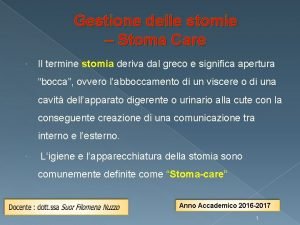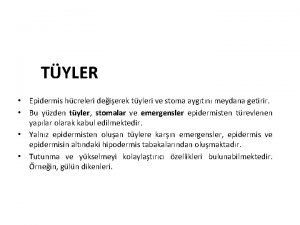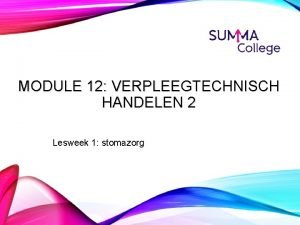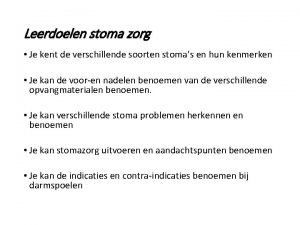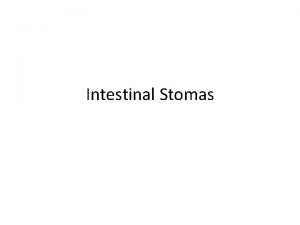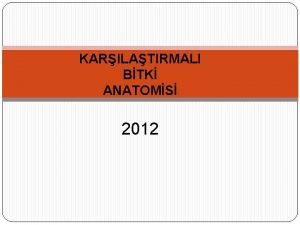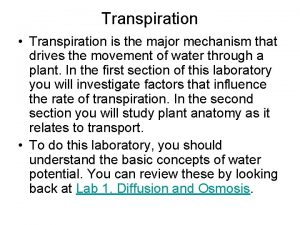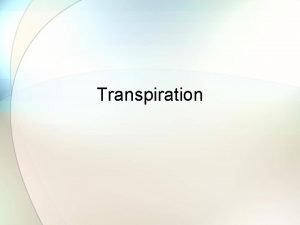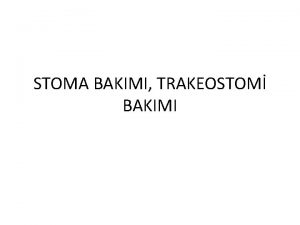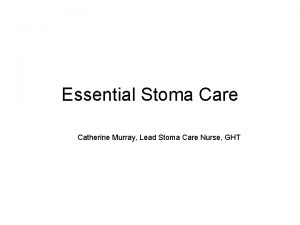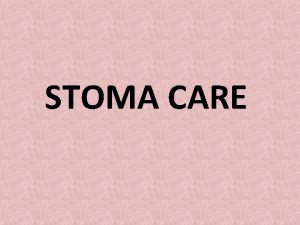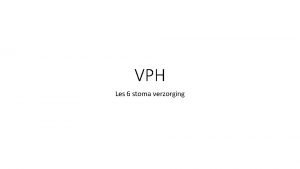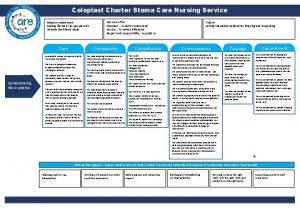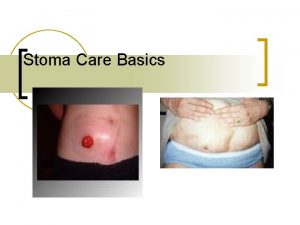Stoma Nursing Care Kathryn Mayne RN Division 1

















- Slides: 17

Stoma Nursing Care Kathryn Mayne RN Division 1. STN Integrated Living Australia(formerly BDNH) 28/6/20017

A + P of Gastrointestinal Tract 1. Food is transported form the mouth to the stomach by the oesophagus 2. The liquid material is passed into the small intestine which consists of (a) the duodenum, approximately 25 cm long. Neutralizes acid and gastric contents. Receives the openings of the bile and pancreatic ducts. (b) the jejunum and Ileum measure about 6 meters long. Major organ for nutrient absorption. 3. Waste material passes into the colon. Functions of the colon include; collection, concentration, transport and elimination of intestinal waste material. The colon consists of (a) the caecum, which lies below the junction of the Ileum with the large intestine. It contains the Ileocaecal valve which prevents reflux into the Ileum. Contents are highly acidic liquid. (b) the ascending colon- contents are acidic liquid (c) the transverse colon- contents are acidic liquid (d) the descending colon- contents become more formed (e) the rectum- formed stool

The intestinal System With thanks to Conva. Tec

Stoma An incised opening that is kept open for drainage or other purposes, such as an opening in the abdominal wall for Colostomy, Ileostomy, and Ileal Conduit. “ Care of the patient with a stoma, for whatever reason it may have been created, is primarily concerned with developing in the patient an attitude of independence and freedom from restrictions on his/her physical, social, and recreational activities once he has been discharged from the hospital”(1) A stoma may be Permanent or Temporary. A permanent Ostomy is constructed when the rectum, colon or bladder have been removed. A temporary stoma (a) May be placed in the small or large intestine or the urinary tract (b) considered to be temporary if it is to be reversed within 6 months of surgery (c) temporary faecal diversions are performed to divert the faecal stream away from obstruction, new anastomosis, operative site or infection.

Types of Stoma END Stoma. The bowel is cut and brought to the surface of the skin and everted into a bud. The distal portion of bowel is removed or oversewn. LOOP Stoma. An entire loop of bowel is brought to the skin surface. The anterior wall of the bowel is opened resulting in two openings. The proximal end is the functioning side and the distal stoma is the nonfunctioning side. (The distal side may also be called a Mucous Fistula due to the normal mucous secretions it produces)

Types of Stoma Double barrel stoma: The bowel is divided and both ends are brought to the skin surface as two separate stomas. It is created when total diversion of bowel is needed. Ileoanal reservoirs – J. Pouch Normally indicated for thin patients under the age of 55 with ulcerative colitis or familial adenomatous polyposis. “A J shaped two-limbed reservoir is constructed from the terminal ileum”(2). It is fashioned into an internal pouch, and attached to the rectal segment that has been stripped of its mucosal lining. This allows semi-liquid stool to be passed through the rectum via normal pathways. May be a two step procedure that requires a temporary Loop Ileostomy.

Types of stomas Ileal Conduit. “use of a segment of the Ileum for the diversion of urinary flow from the ureters. The segment is resected from the intestine with nerves and blood supply intact. The proximal end of the segment is closed, forming a pouch, and the ends of the ureters are sutured to it. The distal end is brought to the outside of the abdominal wall and effaced to form a stoma. The remaining ends of the small intestine are anastomosed to reestablish bowel continuity” (3).

Indications for Ostomy Ileostomy: Crohn’s Disease, Ulcerative Colitis, Cancer, Familial Polyposis, Trauma wounds Colostomy: Cancer, Diverticulitis, Congenital conditions, Trauma wounds, Faecal incontinence, Volvulus of the bowel, Bowel obstruction Ileal Conduit: Cancer, trauma, Congenital conditions, Neurogenic nonfunctioning bladder in which other devices are unsatisfactory.

Bowel surgery that may result in a Faecal stoma Types of surgery for Colon cancer Right Hemicolectomy, Left Hemicolectomy, Transverse colectomy, Sigmoid colectomy Hartmann’s procedure: resection of the diseased portion of the colon with the proximal end constructed into an end Colostomy, and the distal potion closed resulting in a rectal stump. The rectal stump continues to produce mucous. Types of surgery for Rectal Cancer Anterior resection, +/- temporary loop ileostomy Abdominal-Perineal resection, end Colostomy

Psychological Issues to be considered Fear of surgery, impact on body, outcomes, survival and stoma formation Implications of a stoma in their life: eating, sleeping, working, loving, sports Body image issues and self esteem Embarrassment in regards to the stoma: elimination through the abdomen, noise from flatus, smell, leakage Cultural issues Loss of control Sexuality and relationships Reproductive issues How to tell others Returning to work/ sport/ school/ social functions How would you feel if you had a stoma? What would be you concerns and fears?

Role of the Stomal Therapy Nurse Work as part of a multidisciplinary team for the rehabilitation of people with stomas Clinical responsibilities: Pre-op, post-op, Post discharge. Patient teaching, pre-op siting, selecting and fitting appliances, referrals, planning discharge and follow-up. Promote independence for the client and/or significant other in stoma care. Consultant responsibilities. The aim of developing specialist nursing skills is to ensure better patient/client outcomes. Provide emotional support Provide education to the client +/- significant other: applying a bag, problem solving, when to seek help, diet, fluid balance, increased fluid intake, what the stoma and output should look like, clothes, costs and supply of stock, sexuality. Provide education to nurses and other health care workers and ostomy groups. Review and research current practices. Provide evidence based nursing. Administration and managerial responsibilities; record keeping, statistics, stock management, additional stock ordering.

Teaching for independence Use aids Be guided by the client and significant other Use written and visual material Provide support until the client/significant other can manage Provide reassurance and positive feedback Encourage good set up and prompts for the procedure Most stoma clients are provided with a discharge pack from their STN in hospital, encourage them to read when they feel ready Teach to order supplies, mail, email, fax, on-line

Stoma care plan used at Integrated Living Australia

Care plan

Example Patient information provided by Stoma supply companies With thanks to Dansac and Convatec

Refer to the STN The bag is leaking/Skin reaction/change is size of stoma Site problems: retracted, prolapsing, may need a change of appliance Parastomal hernia, ? needs a support garment Stenosis of the stoma, refer to doctor Treatment of granulomas around the stoma Maceration/ulceration of the peristomal skin Type of bag is no longer available Problems with the supply of bags Needs script for additional supplies Would benefit from additional support Client/significant other is struggling to cope with self care AASTN provides Clinical Guidelines for Stomal Therapy Nursing Practice.

References SNELL. Anatomy. “Clinical Anatomy for Medical Students” 1986 (1) + (3) BLACKLEY P. “ Practical Stoma wound and Continence Management” 1989 (2) p 209 CONVATEC. Anatomy guide. “The Intestinal System” “Urinary diversion” MILLER-KEANE. “Encyclopedia and Dictionary of Medicine, Nursing and Allied Health” 1978 DANSAC. Booklet. “Colostomy Care at home”
 Stoma
Stoma Mayne reid
Mayne reid Trasversostomia
Trasversostomia Barnard's parent child interaction model
Barnard's parent child interaction model Nursing diagnosis for obsessive compulsive disorder
Nursing diagnosis for obsessive compulsive disorder Nursing care plan of patients with cataract
Nursing care plan of patients with cataract Levels of nursing care primary secondary tertiary
Levels of nursing care primary secondary tertiary Gramineae tipi stoma
Gramineae tipi stoma Colostomy irrigation contraindications
Colostomy irrigation contraindications Irrigeren ileostoma
Irrigeren ileostoma Stoma problemleri
Stoma problemleri Retractie stoma
Retractie stoma Bowel wash slideshare
Bowel wash slideshare Granugel pasta
Granugel pasta Tallophyt
Tallophyt Terugplaatsen stoma
Terugplaatsen stoma Guard cell
Guard cell Transpiration
Transpiration


